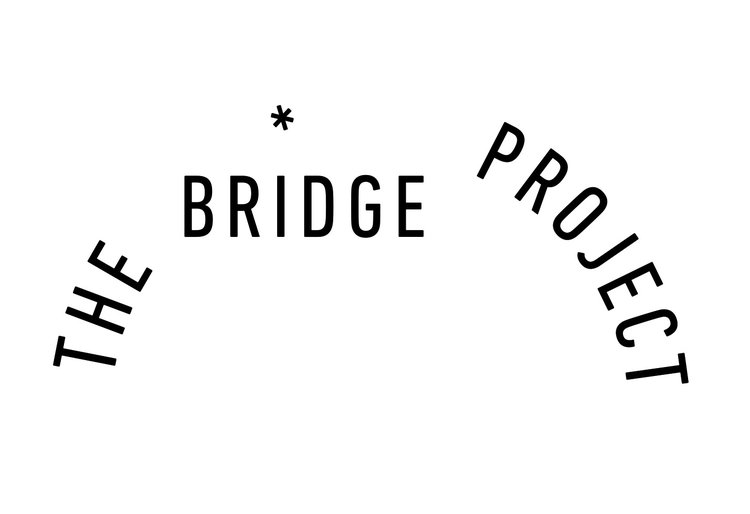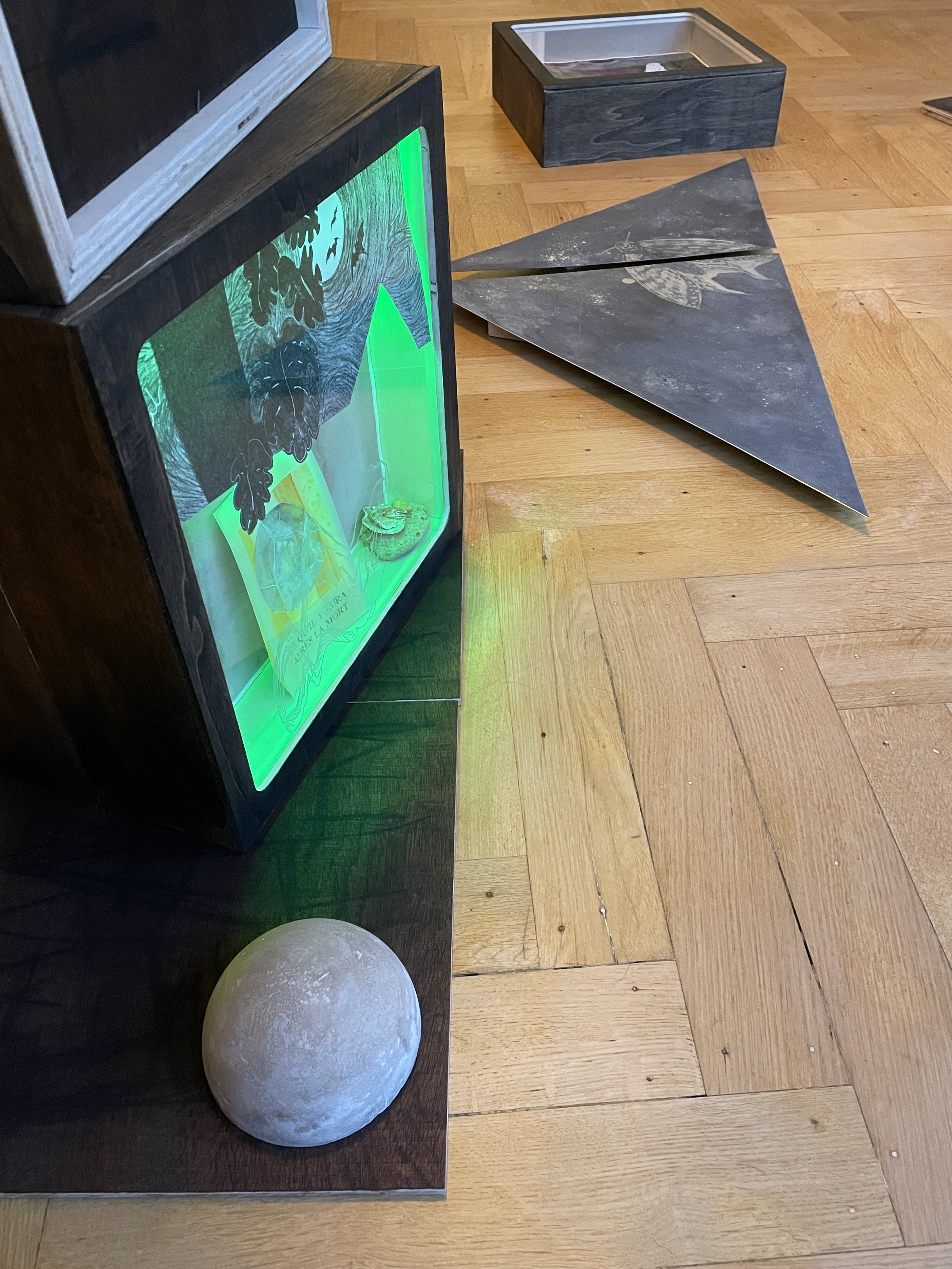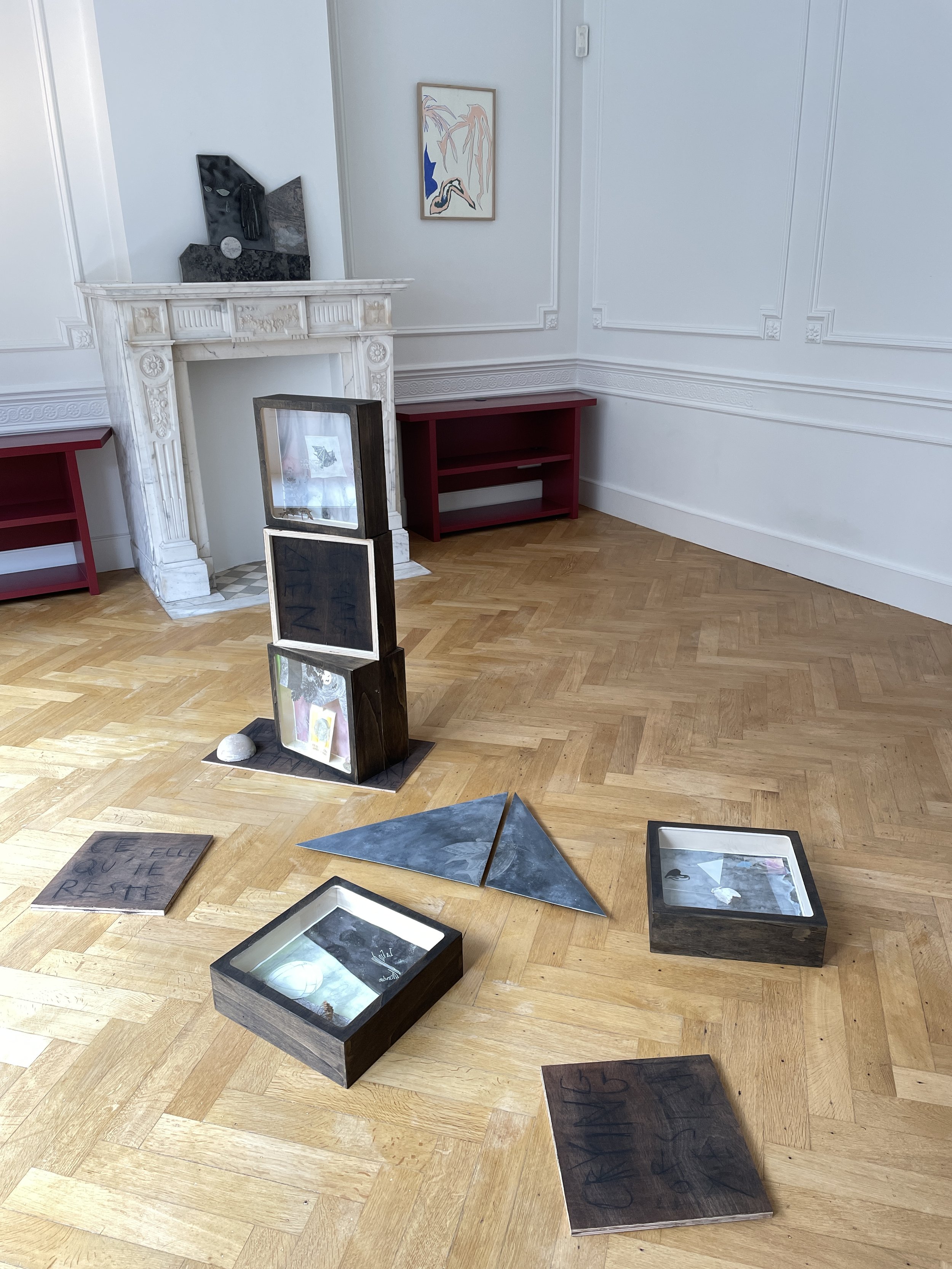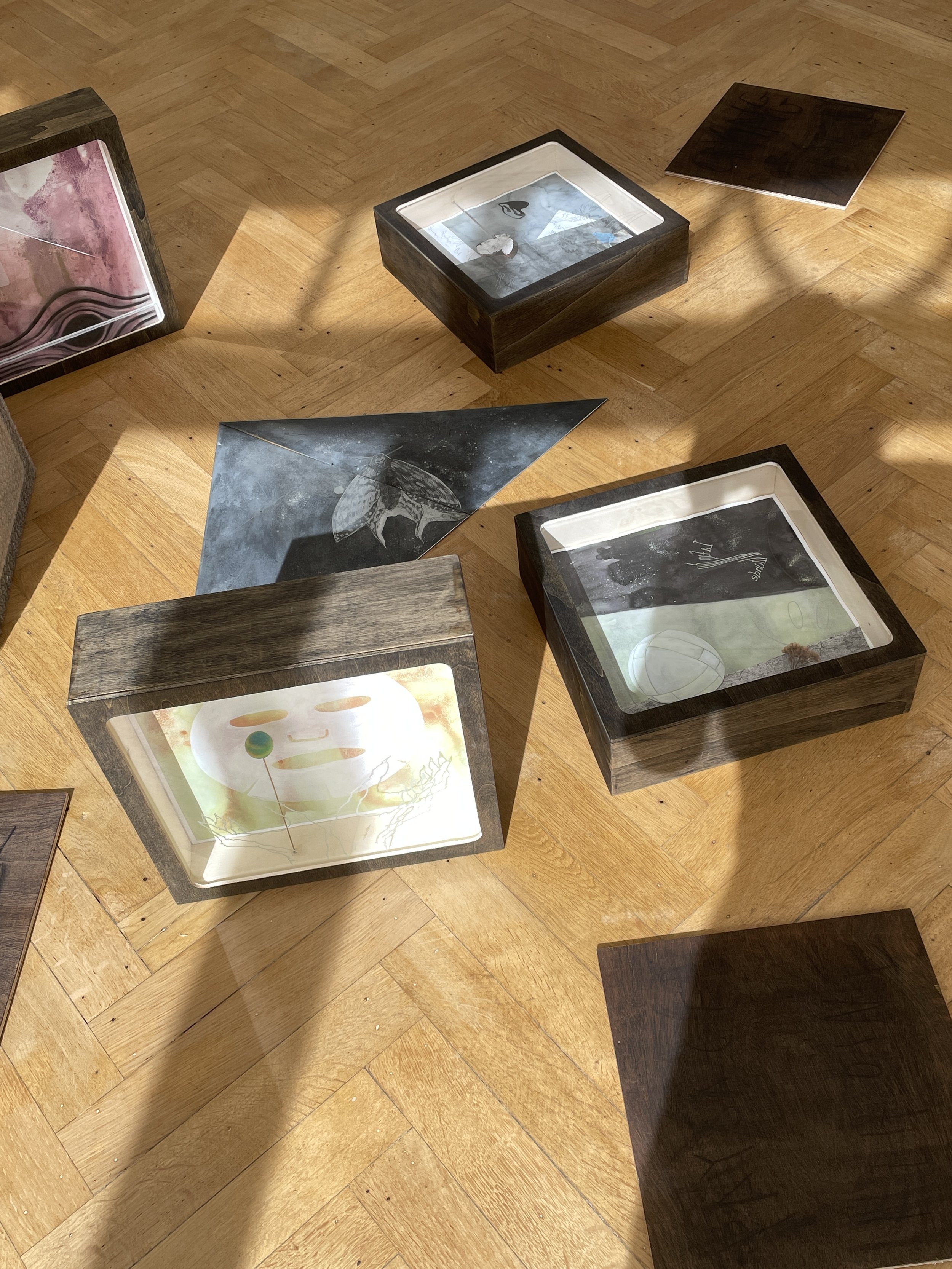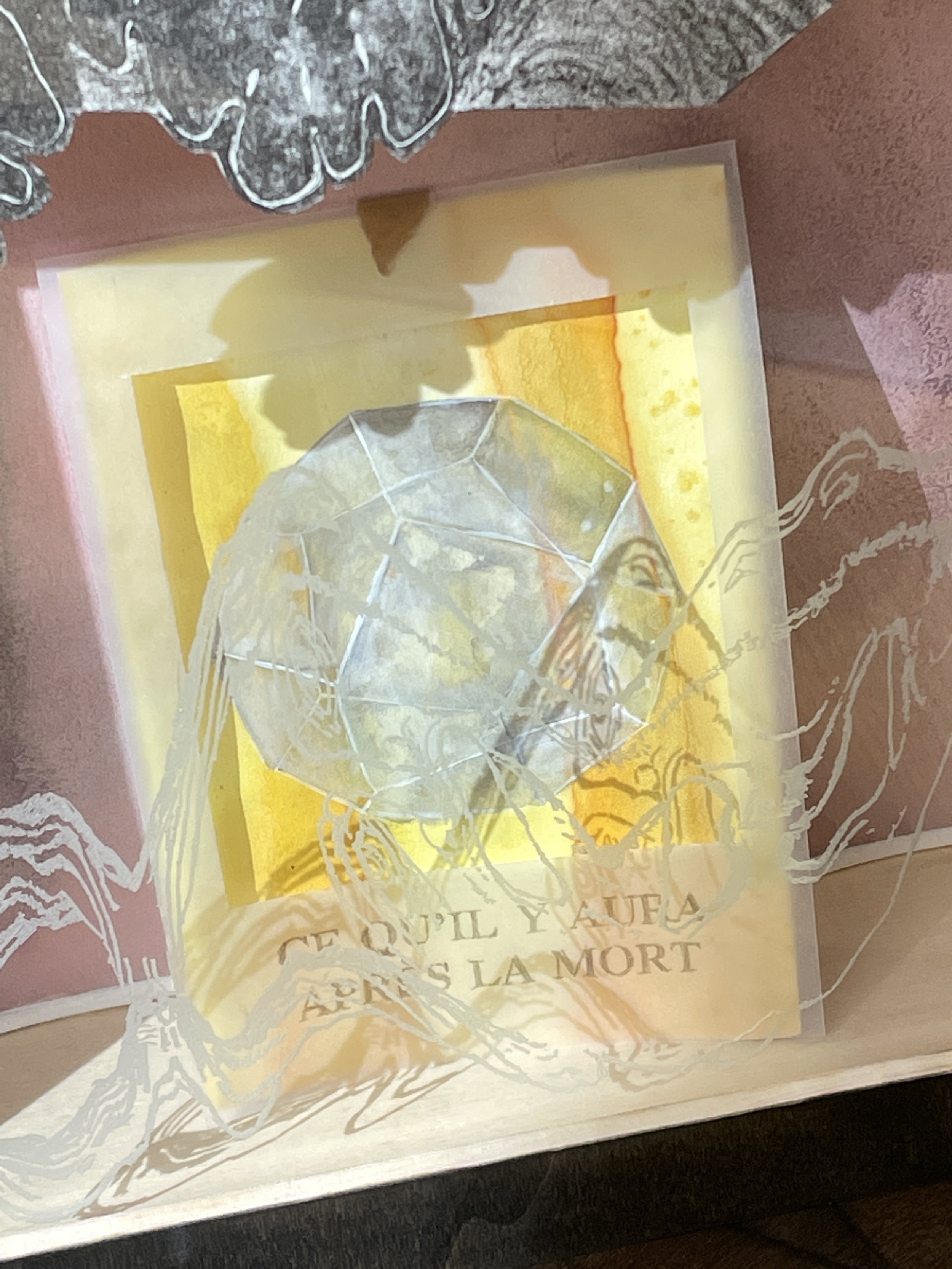Ana Claudia Almeida, Untitled, oil pastel on paper, 2021 (left and right) and Marine Penhouët, Love song for a cloud, black marble, granite and blue stone assemblage, engraving on stone and sculpture, engraved glass, 2021
Marine Penhouët, Love song for a cloud, black marble, granite and blue stone assemblage, engraving on stone and sculpture, engraved glass, 2021; floor installation: mixed media wooden boxes including engraving, photography and drawing, 2021; aqua forte and acid drawing on zinc, 2021; charcoal drawing on wood.
Marine Penhouët (floor), details of installation of mixed media wooden boxes including engraving, photography and drawing, 2021; aqua forte and acid drawing on zinc, 2021; charcoal drawing on wood
Left to right: Marine Penhouët, drawing and engraving on paper and glass (2021); Robin Faymonville, oil on canvas, gouache and acrylic on paper (2021); Ana Claudia Almeida (upper right), oil pastel on paper (2021)
Robin Faymonville, oil and pigment on canvas. 2021
MOVING SCAPES
With Ana Claudia Almeida, Robin Faymonville and Marine Penhouët
On view as part of the Brussels Drawing Week at Sarah Zucker´s, 16 rue Darwin, 1190 Brussels, September 11th - 19th 2021
Mirroring man´s conception of the environment, reflecting his hopes and despair facing nature´s unintentionality; landscape fascinates occidental art for centuries. Its representation, which can only be partial and the result of a projection, informs us on the spatial perception and cognitive categories of certain periods in time, as well as their subjective interpretations.
Ana Claudia Almeida, Marine Penhouët and Robin Faymonville propose, in Moving Scapes, their visual constructions and deconstructions of a subject matter that echoes in our imaginaries haunted by the Anthropocene. They convey a certain romantic ideal, tainted with cynicism, of a return to nature, somewhere between real and imaginary landscapes.
Human presence appears in the background of Ana Claudia Almeida´s works. In her drawings, variation of her monumental paintings, vivid colors suggest a urban toxic imprint, that she opposes to the earthy palette of the land, the mountains, the rivers and the vegetation. Her topographies and moving landscapes mix indeed the artificial and the organic and become the storytellers of a subjective story in which we might perceive the characteristic tones of some of Rio de Janeiro´s hills, where the artist lives.
Robin Faymonvilles´s primitives sceneries dialogue with Ana Almeida´s sensoriality. Representing states of consciousness more than actual memories, the artist´s drawings and paintings use a voluntarily reduced pictural vocabulary, repeated until the exhaustion of the colors and of the movement, leaving space to the inform; possibly recalling outsider or even cave art by their simplicity. Meditative or therapeutic exercise, between indolence and urgency, Robin Faymonville´s production stems from drawing, graphic and writing and blooms in a universe tainted with philosophical thinking and literature. Here, hierarchies disappear and both drawing and painting are being used as medium and as an object, each practice feeding the other in an infinite loop.
This horizontal and permanent « mise en abîme » of artistic and literary references, of shapes and images from high or low culture also characterize Marine Penhouët´s artistic research. Echoing the horizontality of her references, the artist´s fluid use of techniques such as sculpture, engraving, drawing or painting, highlights her refusal of hierarchies. Indeed, while a mineral drawing – sculpture reinvents elements taken from De Chirico´s “The Song of Love”, a painting on wood echoes with a composition taken from The Cure´s “Boys Don´t Cry” album. This proposition is further synthetized by a series of objects – artworks made as scientific dioramas and set up as archeological ruins, reminding a photography of Petra´s Farao column, hanging nearby. Basis of a vocabulary and mythology personal to the artist, Marine Penhouët´s artworks reveal a stratified thinking, in the manner of geological layers and in which techniques, temporalities and symbols collide, mixing iconography from vinyl records from the 80s or rave parties from the 90s with fragments of classical engravings and paintings, poetry and Art History, in an assemblage of ideas and references that works as a romantic and acid riddle.
Moving Scapes proposes, with this intuitive dialogue between figuration and abstraction, an immersion in the subjective universes of three young artists, an overview of their intimate geographies and therefore a possible portrait, poetic and cruel, of their vision of a society in which the human appears less and less relevant face to the atemporal and universal sublime of the rocks, the earth, the clouds and the slow, imperceptible movement of the ever changing landscapes.
Ana Claudia Almeida (Rio de Janeiro 1993, lives and works in Rio de Janeiro, Brésil): Ana Cláudia Almeida's investigation is based on the languages of painting and drawing. She works with elements such as time, action, and landscape intertwined in the construction of a space for subjectivity. She understands surfaces as storytellers of their own lives and specific time frames. From the ideas of nature, artificiality, and normativity, she creates distinct elements that make up plastic systems. Bachelor in Industrial Design from the Universidade do Estado do Rio de Janeiro with partial completion of the undergraduate program at Virginia Commonwealth University. Resident of the programs Pivô Pesquisa (2020), C.M.A. Hélio Oiticica (2019), Valongo Festival Internacional (2018). Nominated for the Pipa Prize in 2020 and finalist for the EDP das Artes Prize (2018). Solo exhibitions at Quadra Arte (2021) and at the Niterói Art Foundation (2018). Selected group showsinclude institutions as Museu de Arte Moderna do Rio de Janeiro, Museu de Arte do Rio, Instituto Tomie Ohtake, Paço Imperial do Rio de Janeiro, Museu da República, Galpão Bela Maré and Solar do Abacaxis. Her work was recently acquired by the Museu de Arte do Rio and Inhotim collection.
Marine Penhouët (Lorient 1989, lives and works in Brussels): multidisciplinary artist, Marine Penhouët transists between Art History, romanticism, symbolism and contemporary references, establishing links between imaginary and existing landscapes, the present and the past, through deconstruction, repetition and the appearance of her processes.
Marine Penhouët studied engraving at the Ecole Européenne Supérieure d´Art à Quimper and at the Académie Royale des Beaux-Arts in Brussels where she also received a teaching diploma. She further developed her multidisciplinary practice, notably in lithography in the studios of the kunstacademy in Karlsruhe in the frame of n Erasmus mobility or in the studio of Michael Woolworth in Paris where she acquires an experience in edition and printing. She is also the founder of the artist run space Kabinet (Brussels 2013 - 2018). After her Master in France, she moves to Brussels where she founds the editing house Hypnotismezine.
The artist shows her work since 2009, mainly in France and in Belgium. Among her recent exhibitions are : Boltra, Moerdijk sculpture project show, Brussels ; WeArtixelles, parcours d’artistes, Brussels ; Ce qu’il reste, Trône, Brussels (curatoria) ; Le Horla, Sterput, Brussels ; À géométrie ternaire, La centrale, Brussels ; L'ombre des choses, Tropicana, Brussels (curatoria) ; Wheeling, la Réserve, Brussels (solo) ; Le désert dans la chambre, La réserve, Brussels ; Le chant d'amour, Area42, Brussels ; Sous la morsure du soleil, Maison Bergamini, Brussels (solo) ; La cage d'escalier, Brussels ; Là-bas, Sterput, Brussels ; Zone Bleue, curatoria Lola Meotti, Pop-Up, Brussels ; Bruxelles 16 facettes, Maison Bergamini, Brussels ; Corpus quartier, Hypercorps, Brussels ; Yellow Bridge, Le Kabinet, Brussels (curatoria) ; Art et Archery, Soignie (BE) ; Botanique, studio of the artist Abel Pradalier, Paris ; Dessin Quotidien #2, Satellite Brindeau, Le Havre ; Renverse, Le Terrier, Paris ; Printnoiz !, Le dernie Cri, La Friche Belle de Mai, Marseille ; 23ème Prix de la Gravure, Centre de la gravure, La louvière (BE) ; Furiosité, Paris ; Alice, Maison Pelgrims, Brussels ; Hallez tongue au tiaple!, Atelier d’Estienne, Pont-Scorff (FR) ; Confort moderne, Clovis 15, Brussels et Becs et ongles, Espace Couac, Lyon.
Robin Faymonville (Liège 1995, lives and works in Brussels): Robin Faymonville articulates his artistic production in a space between litterature and visual arts, in particular in painting seen as a transposition of drawing protocols exhausted in his gesture and thematics, in particular the landscape considered by the artist as one of the most intriguing éléments of Art History.
In Parallel to his philosophical studies, Robin Faymonville studied at La Cambre painting school where he developped a practice mixing performance, writing and painting. His work has been shown in the frame of the Festival de la Jeune Vidéo (Paris), Médiatine Prize (Brussels) and Art au Centre (Liège). He is the co-founder of the BUREAU DES OGRES, exhibition platform dedicated to connections between visual arts and contemporary literature.
